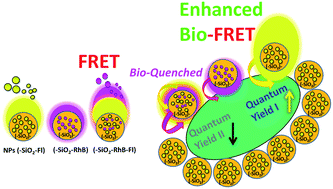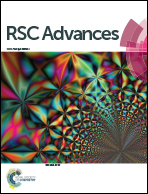Synthetic non-classical luminescence generation by enhanced silica nanophotonics based on nano-bio-FRET
Abstract
Fluorescent silica nanoparticles (NPs–(SiO2–Fluo)) were synthesized based on the classical Störber method for cyanobacteria labelling. Modified mono-coloured SiO2 NPs with fluorescein (Fl) and rhodamine B (RhB) were obtained (NPs–(SiO2–Fl) and NPs–(SiO2–RhB)). Moreover, multi-coloured SiO2 NPs, via the incorporation of both emitters (NPs–(SiO2–RhB–Fl)), were tuned for optimal emissions and the biodetection of cyanobacteria. NPs–(SiO2–Fl) and NPs–(SiO2–RhB–Fl) were optimized for detection via laser fluorescence microscopy and in-flow cytometry with laser excitation and fluorescence detection. By TEM, homogeneous SiO2 NPs of 180.0 nm in diameter were recorded. These sizes were slightly increased due to the covalent linking incorporation of fluorescent dye emitters to 210.0 nm with mono-coloured fluorescent modified amine-organosilanes, and to 340.0 nm in diameter with multi-coloured dye incorporation. NPs–(SiO2–Fluo) showed variable emission depending on the dye emitter concentration, quantum yield and applied luminescent pathway. Thus, mono-coloured NPs–(SiO2–Fl) and NPs–(SiO2–RhB) showed diminished emissions in comparison to multi-coloured NPs–(SiO2–RhB–Fl). This enhancement was explained by fluorescence resonance energy transfer (FRET) between Fl as a fluorescent energy donor and RhB as an energy acceptor produced within the nanoarchitecture, produced only in the presence of both fluorophores with the appropriate laser excitation of the energy donor. The depositions of the nano-emitters on cyanobacteria by non-covalent interactions were observed by TEM and laser fluorescence microscopy. For multi-coloured NPs–(SiO2–RhB–Fl) labelling, bio-FRET was observed between the emission of the nano-labellers and the natural fluorophores from the cyanobacteria that quenched the emission of the whole nano-biostructure in comparison to mono-coloured NPs–(SiO2–Fl) labelling. This fact was explained and discussed in terms of different fluorescence energy transfer from the nanolabellers towards different natural chromophore coupling. In the presence of NPs–(SiO2–RhB–Fl) and NPs–(SiO2–RhB), the emission was coupled with lower quantum yield chromophores; while upon the application of NPs–(SiO2–Fl), it was coupled with higher quantum yield chromophores. In this manner, for enhanced luminescent nanoplatform tracking, the multi-coloured NPs–(SiO2–RhB–Fl) showed improved properties; but more highly luminescent bio-surfaces were generated with mono-coloured NPs–(SiO2–Fl) that permitted faster cyanobacteria detection and counting by laser fluorescence microscopy, and by in-flow cytometry with laser excitation and fluorescence detection.



 Please wait while we load your content...
Please wait while we load your content...